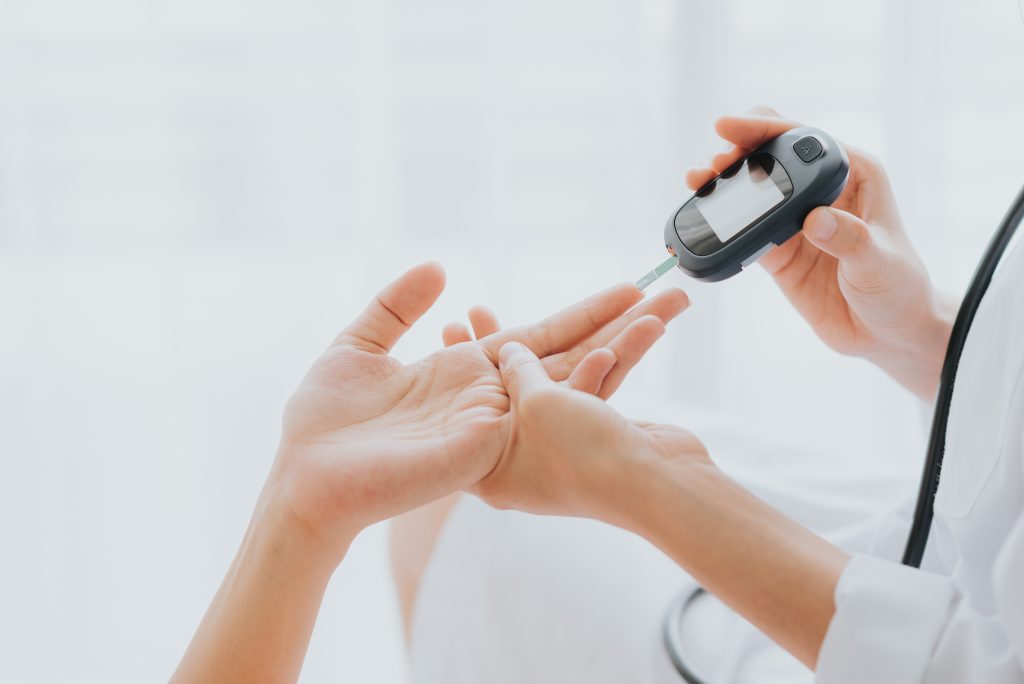How Does Diabetes Affect the Eyes?

Diabetes occurs when your body does not properly process food as energy. When you have diabetes, your body either does not respond to or does not produce insulin, a hormone that delivers glucose (blood sugar) to the cells in your body. Having too much glucose in the bloodstream, outside the cells where it belongs, can cause damage to the blood vessels and nerves that run throughout your body, including the eyes.
Eye Conditions Caused by Diabetes
Diabetes can affect the eyes in several ways.
Blurry Vision
When you have diabetes, fluid can move into and out of the eye because of high blood sugar levels. This can cause the lens of the eye to swell. As the shape changes, blurriness results because the lens is the part that focuses light onto the back of the eye.
Cataracts
If left unchecked, high blood sugar slowly damages blood vessels throughout the body. This includes the tiny blood vessels in the eyes. And when diabetes affects these blood vessels, there's the risk of cataracts and other eye conditions. Cataracts result from high sugar levels in the aqueous humor.
Glaucoma
Having diabetes doubles your odds of glaucoma, a condition that puts added pressure in your eye. This extra pressure can damage the retina and the optic nerve, the main eye nerve for sight. You likely won't have symptoms early on.
Diabetic Retinopathy
Diabetic retinopathy is a complication of diabetes that affects the eyes. It's caused by damage to the blood vessels of the light-sensitive tissue at the back of the eye, the retina. At first, diabetic retinopathy might cause no symptoms or only mild vision problems.
Diabetic Macular Edema
Sometimes, tiny bulges (microaneurysms) protrude from the vessel walls, leaking or oozing fluid and blood onto the retina. This fluid can cause swelling (edema) in the central part of the retina (macula). This serious eye complication called diabetic macular edema can cause vision problems or blindness.
Who Is Likely to Develop Diabetic Eye Disease?
Anyone with any kind of diabetes can get diabetic retinopathy — including people with type 1, type 2, and gestational diabetes (a type of diabetes that can develop during pregnancy). Your risk increases the longer you have diabetes. Over time, more than half of people with diabetes will develop diabetic retinopathy.
What Are the Symptoms of Diabetic Eye Disease?
There are no early symptoms of diabetic eye disease. You may have no pain and no change in your vision as damage begins to grow inside your eyes, particularly with diabetic retinopathy.
When symptoms do occur, they may include
- blurry or wavy vision
- frequently changing vision—sometimes from day to day
- dark areas or vision loss
- poor color vision
- spots or dark strings (also called floaters)
- flashes of light
If you experience any of these symptoms, schedule an exam with an eye doctor in West Florida right away.
How Do Eye Doctors Diagnose Diabetic Eye Problems?
Eye doctors can check for diabetic retinopathy as part of a dilated eye exam. The exam is simple and painless — your doctor will give you some eye drops in your pupil and then check your eyes for diabetic retinopathy and other eye problems.
Drops placed in your eyes widen (dilate) your pupils to allow your doctor a better view inside your eyes. The drops can cause your close vision to blur until they wear off several hours later.
What Can I Do to Reduce the Risk of Diabetes-Related Eye Conditions?
To reduce the risk of diabetic eye problems, you need to start by reducing the risk of diabetes. Some of the most common ways to reduce the risk of diabetes include
- Eat a balanced, healthy diet
- Control your blood sugar levels
- Lower your blood pressure and cholesterol
- Stop smoking
- Reduce your exposure to harmful UV rays
Schedule an Eye Exam Today
Contact Gulf Coast Vision Center today at one of our Pace, Milton, Crestview or at our Pensacola locations on Nine Mile and in East Hill to schedule a comprehensive eye exam.
